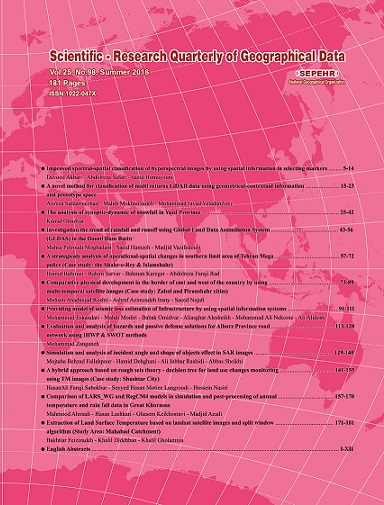Document Type : Research Paper
Authors
1 Ph.D student of Surveying and Geospatial Eng., Faculty of Engineering, University of Tehran, Tehran, Iran
2 M.Sc. of Geodesy &Geomatics Engineering-K. N. Toosi University of Technology
Abstract
Extended Abstract
The Digital Terrain Model (DTM) is a statistical presentation of the earth surface using some points with predefined 3D coordinates. Extracting the DTM as an important product of photogrammetry and remote sensing that is the basis of many practical projects, has always been considered by experts. LiDAR is a powerful equipment that can provide 3D point cloud with high accuracy from the earth. Nowadays, advances in technology make the generating 3D point cloud from the digital aerial images by dense matching feasible. These point clouds represents an approximate Digital Surface Model (DSM) of the earth. The DSM contains both terrain points and off-terrain points, but the DTM contains only the terrain points. In other words, the DTM presents a bare earth without any natural and artificial objects. Generating the DTM using the DSM is a challenging topic in photogrammetry and remote sensing. In this paper, an algorithm with two independent approaches is proposed. Before beginning the process, the irregular point clouds was gridded, interpolate and convert to the image by specifying a point interval.
The first proposed approach was a progressive morphological filter that detects the off-terrain points from the DSM. This approachused the simple morphological filter in a specific procedure with four steps. In the first step, a minimal surface was generated by identifying the points which have minimum elevation in predefined scan windows. The structural element of the morphological filters should be determined. As it is a progressive filter, a vector that contains the structural elements sizes was determined in the second step. In the third step, a morphological opening was applied on the point cloud with a structural element in accordance with the produced vector in step1. For each window size in the vector, an elevation threshold was calculated by multiplying the interval distance and supplied slope parameter. Then, the difference between initial surface and the result of applying the morphological opening was computed. The points with the difference values of more than the calculated elevation threshold were selected as off-terrain points.
In the second approach, an iterative procedure was designed which was based on morphological filters. The geodesic dilation was a combination of traditional morphological filter. Although the morphological filters operated based on the image and structural element, geodesic dilation operated with two images including the mask and the marker. In geodesic dilation of size one, the marker image was dilated by an elementary isotropic structural element and the resulting image was forced to remain below the mask image. In other words, the mask image acts as a limitation for the dilated marker image. Image reconstructing by using geodesic dilation on an image was done by performing some successive geodesic dilations on the image. The results of geodesic dilation was depending on the elevation value. If this value was low, only the building ridge line was extracted andoff-ground. Moreover, if the elevation value was high, some of the bare earth was cut as off-terrain, wrongly. Hence, an iterative procedure was proposed to make the extracting of the most of the object possible. In this way, the probability of error was reduced. In each loop, the elevation value was increased and some objects was extracted using geodesic dilation. Among the extracted parcels in each loop, the parcels which have local range variation more than a threshold were selected and the others were removed. The local range variation for each point was computed by specifying a window and calculating the difference between maximum and minimum elevation value in that window. This procedure was repeated utill analyzing all of the elevation values.
Finally, the results of detecting the off-terrain points using both of approaches were accumulated to acquire the final class of off-terrain points. Then, this points were removed and the cubic interpolation was employed in order to retrieve the elevation of the lost points and to generate the DTM.
In order to analyze the performance of the proposed algorithm, 7 test areas were used. The point cloud of the areas 1, 2 and 3 were produced using dense matching of digital aerial images (Ultracam) by National GeographyOrganization of Iran. The point spacing of these areas is about 0.5 meter. The point cloud of the areas 4, 5, 6 and 7 were captured using LiDAR by International Society for Photogrammetry and Remote Sensing. The point spacing of these areas were 3, 1, 2.5 and3meters respectively. The data set covered the most of the features such as steep slopes, mixture of vegetation and buildings, bridge underpasses, roads and buildings with various roof shapes. Evaluating the performance of proposed algorithm represented the 4.85% error for extracting the off-terrain points and 0.68 meter error for generated DTM in all test areas, averagely. The evaluation results clarify the ability of proposed practical algorithm in generating the DTM using the DSM.
Keywords

